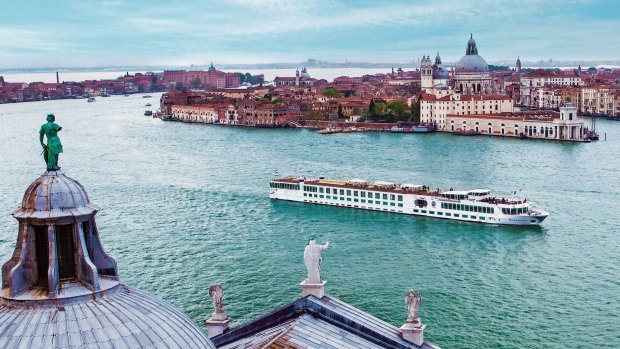
The River Countess sails through Venice.
I have a blind date with history, and already I'm smitten. True, the romance isn't quite instant. The approach to Venice is one of dismal smokestacks and flyovers, and buses belch on Piazzale Roma, coughing up suitcase-lugging tourists. I make the mistake of deciding to walk from here to my ship: a 20-minute slog across railway lines and past rusting machinery under the ludicrous, looming bulk of ocean-cruise vessels that float like bloated blimps in La Serenissima's most uninspiring corner.
I spy my ship, River Countess, at its San Basilio mooring with relief. Compared with cruising's behemoths, this Uniworld ship is a dainty elegance, like a whimsical float dreamt up for a Venice carnival. Scarcely have I showered and settled into dinner than we set sail into another world. Sunset caresses the Renaissance facades of wave-washed palaces, pink-winged pigeons flutter and basilica domes bulge. Figures perambulate on marble promenades against Gothic arches, presenting Canaletto paintings come to life. We drift by St Mark's Square and the Doge's Palace. The church of San Giorgio Maggiore opposite glows orange against a purple sky. Venice is a grand romance, and I'm head over heels.
Although I've been to Venice twice before, my heart has never gone pitter-patter in quite this way. Venice is designed to be approached from the sea and admired from the water, but few visitors actually see it like that. I've always thought of Venice as a beautiful but somewhat claustrophobic city of narrow canals and crowded, canyon-like alleys. From the water, though, it's simply beautiful. From the deck of the River Countess, post-prandial red wine in hand, it's hard to imagine a better, more theatrical backdrop to a river cruise.
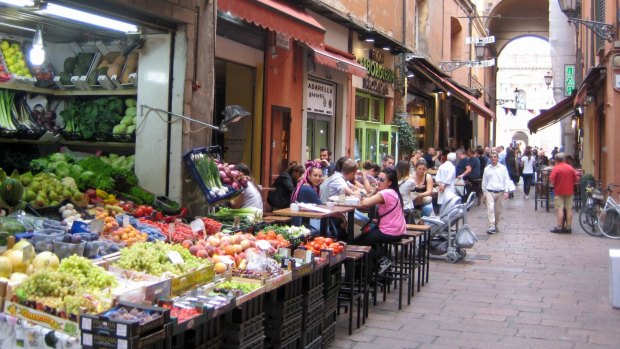
Via Pescherie Vecchie in Bologna.Credit: Brian Johnston
Next morning, I fling back my cabin curtains and find we're docked at the Riva dei Sette Martiri. It cannot be any more than two kilometres from our embarkation point the previous evening, but what's packed in between the two is enough to make me dizzy: a thousand years of turrets and towers, palazzos and piazzas, all knitted together by humped bridges that create some of this waterlogged city's highest vantage points. It's a quick walk with our guide along the waterfront, eyes goggling at churches and the Bridge of Sighs, and already we're in the Doge's Palace. It erupts in gilt-beamed ceilings and fabulous artworks that ought to be famous except that, in this city, such things are commonplace.
That afternoon, some passengers head off to Giudecca for a glassworks tour. I opt instead to wander by myself around Castello district where the ship is docked. It's little frequented by tourists, short on souvenir shops, but big on neighbourhood atmosphere. Pink bed sheets are strung out to dry between red buildings and old men mutter from cafe tables. Cats slink, cutlery tinkles from open windows, televisions crackle. I happen upon the city's old arsenal, studded with statues and winged lions, its Gothic windows gaping at a pretty square.
River cruising provides a clever form a seduction, always leaving you panting for more. I could spend a week in my floating luxury hotel, moored at such a location, but next day we're already sailing out across the Venetian Lagoon, our ship slipping between channel markers as herons strut just metres away in shallow water. Little islands topped by crumbled buildings float in an early mist, but as we turn along elongated Pellestrina island, the sky turns brilliant blue behind houses orange and jaunty green. I sit on the deck, shading my eyes and listening to the commentary from our local guide and art historian Louisa, whose children go to school on Pellestrina.
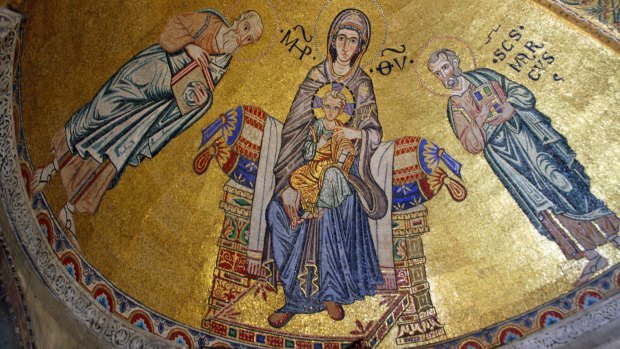
Mosaics from St Mark's Basilica in Venice.Credit: Brian Johnston
As we finish lunch, we're docking at Chioggia at the southern end of the lagoon. From here it's a coach drive across marshland and cornfields to Padua, an energetic university and pilgrim town. A dome-bulging basilica houses the tomb of St Anthony, which is plastered with messages and photos from supplicants. Outside, students canoodle on park benches and chatter in cafes, loud as lorikeets at sundown. Padua is a delightful counterpoint to Venice, with its lived-in appeal, salami-draped market squares and boutique shopping. I linger in the main street, slurping gelato and sticky-beaking on a crowd where locals still far outnumber tourists. It leaves me just enough time to nip around Padua's impressive artistic legacy: an equestrian statue by Donatello, frescoes by Giotto, Venetian paintings and Etruscan pottery.
We find our ship again at Porto Viro; it has moved from the Venetian Lagoon on to the Po River during our excursion. The road back is flat, reed-lined and cluttered with petrol stations and plant nurseries. Yet when the ship sails, we're almost immediately into national park. Late light shimmers on the water, and trees are Pollock splashes against the palest of silver skies. Swans paddle. In truth, this is about as beautiful as the Po River gets; this is a waterway tending to locks and levees rather than grand scenery, and we don't see much of its length on this cruise.
There's no doubting the stature of our excursion destinations, however. The next day we're being lead by our guide, Maria, into the centre of medieval Bologna, with its burnt-red buildings and flag-stoned squares. "To cross the road in Italy you have to be brave," shouts Maria as we dash between speeding Vespas. Bologna's main square is traffic-free, however. "We Bolognese always meet here under the statue of Neptune," she explains. "It's rather surprising that a pope ordered this statue of such a beautiful naked man," she adds, apparently oblivious to papal excesses of days gone by. Neptune is indeed rather flamboyantly exposed, buttocks taut as watermelons. Beneath, a nymph holds out her breasts as water spurts.
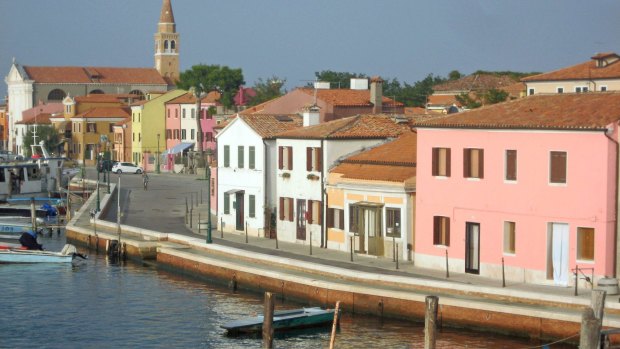
Riva degli Schiavoni waterfront in Venice.Credit: Brian Johnston
Bologna is a city of indulgence, renowned for its left-leaning politics and rich cuisine. Its most famous dish is tagliatelle al ragu, transformed beyond Italy into spaghetti bolognese, but its delicatessens and market stalls are fat with mortadella, ham, cheese, vinegar and asparagus.
We lunch at Cantina Bentivoglio, an atmospheric cellar of vaulted ceilings and empty wine bottles encased in years of melted wax. Louisa, who has been making pasta here since the 1970s, gives us a quick lesson in pasta making. She uses a giant rolling pin called a matterello to flatten and roll her pasta dough, working fast so it doesn't dry out. From the sheets she cuts strips of varying widths, pulling linguine, fettucine and taglierini into the air with all the flourish of a magician with her rabbit.
On our last afternoon, we're sailing on the Venetian Lagoon once more, past the islands of Torcello and Burano, where churches and houses seem to float in the pale water. Few visitors to Venice see much of the lagoon at all, and this is the grandest of overviews. Gothic mansions loom out of the falling dusk as we sail back into Venice. The canals are purple and baroque clouds stud the sky above campaniles. Later, we're taken on an exclusive after-hours visit to St Mark's Basilica, sneaking into semi-gloom. An attendant flicks a switch to a collective gasp as the interior erupts in glittering, golden mosaics depicting sad-eyed saints.
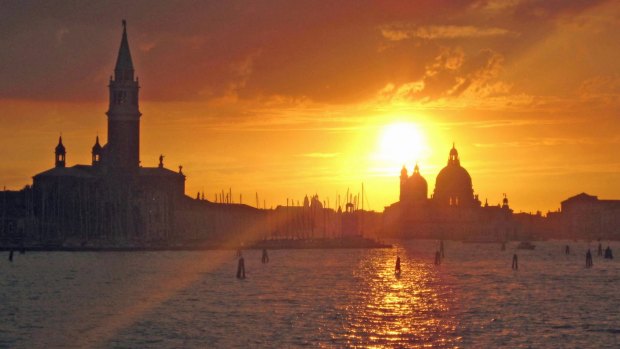
Sunset over Venice from the deck of the River Countess. Credit: Brian Johnston
Outside, string quartets are playing under the cafe arcades of St Mark's Square. Shadows lurk under the arches of the Doge's Palace, and water gurgles as we walk back to our ship. At moments such as these, this maddening, artificial, overcrowded, dying city is utterly bewitching. I want to don a mask and dance under the stars, but perhaps that's just the folly of falling in love.
TRIP NOTES
MORE INFORMATION
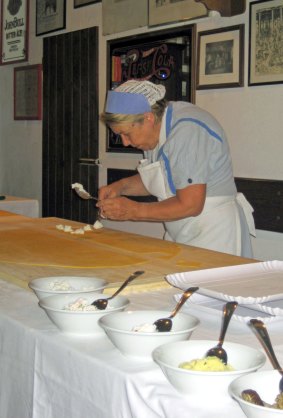
Louisa demonstrates pasta making at Cantina Bentivoglio.Credit: Brian Johnston
GETTING THERE
Emirates flies from Sydney and Melbourne to Dubai (14½ hours) with onward connections to Venice (6½ hours). Phone 1300 303 777, see emirates.com/au.
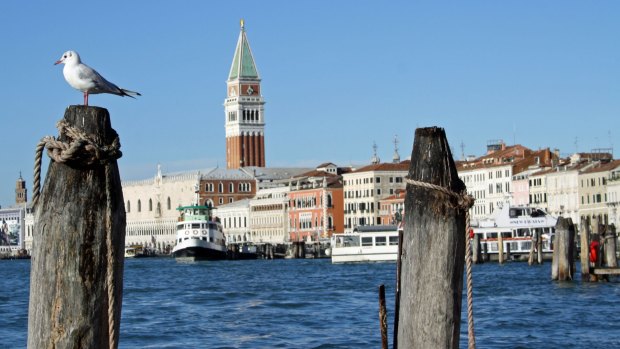
Riva degli Schiavoni waterfront in Venice.Credit: Brian Johnston
CRUISING THERE
Uniworld's 10-day "Gems of Northern Italy" itinerary starts with two hotel nights in Milan and continues with a seven-night cruise on the Venetian Lagoon. It differs somewhat from the 2015 itinerary described by the writer. Some departures are part of Uniworld's "Generation Family" itineraries for multigenerational cruisers. Prices start from $5159 a person twin share, including meals, beverages, guided shore excursions, gratuities and transfers. Phone 1300 780 231. See uniworld.com/au.
Brian Johnston was a guest of Uniworld.
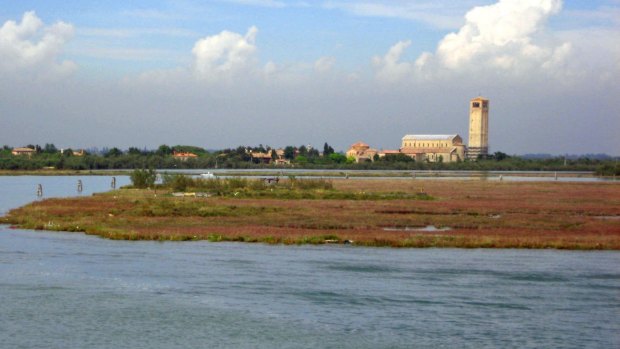
Torcello island in the Venetian lagoon.Credit: Brian Johnston
The unpredictable Po
Several things about this river cruise differ from other river cruises in Europe, largely because the Po River is prone to both flooding and low water levels, making navigation difficult.
• Cruises only sail upriver as far as Polesella, about 60 kilometres inland, and no shore-excursion destinations on this part of the itinerary are on the riverbanks, necessitating coach transfers.
• The ship has to navigate a short section of Adriatic Sea between the Venice Lagoon and Po River, during which passengers are obliged by regulations to disembark, because conditions can be rough.
• There's little sense of onward journey, but the cruise does spend ample time sailing back and forth across the gloriously atmospheric Venetian Lagoon at various times of the day and evening.
• Cruises don't depart over the winter months (early November to mid-April), when the Venetian Lagoon can be surprisingly chilly and prone to sea mists.
Uniworld has tried a few variations on its Italian itineraries over the years, and has now wisely settled on a short section of the Po and much more time on the Venetian Lagoon. This year, a full-day visit to the island of Burano and adjacent Mazzorbo has been added.
Sign up for the Traveller Deals newsletter
Get exclusive travel deals delivered straight to your inbox. Sign up now.